
|
READ
ABOUT US! |
|

Bill
Becher, L.A. Daily News outdoor writer and photographer
went to Bodie with us in September. Read what he wrote about the trip. Click
the photo to link to the story. |
|
|
|
TIME
TO
RENEW!
The
birth of a new year is also the death of California campfire
permits issued in 2004. Visit your local land management agency (BLM,
NPS, USFS or State Parks) to renew your campfire permit for the
2005 calendar year.
|
|
Click on
the photo below to read more about Cerro Gordo.
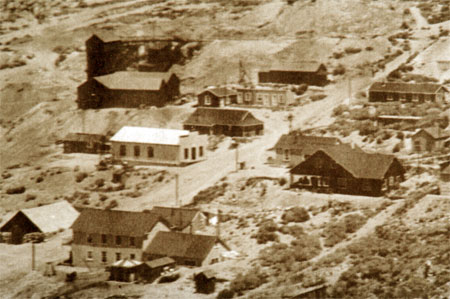
|
|
|
|
BOOK
A TOUR
BUY
STUFF
Ecological
4-Wheeling Adventures
Click
on either graphic below to get there.
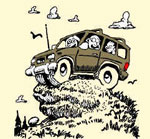
Ecological 4-Wheeling Adventures (ECO4WD) offers more than 20 exciting four wheel drive backcountry adventure tours, SUV excursions, 4WD classes and 4-wheeling trainings.
Their adventure tours range from one-day outings into Southern California's mountains and deserts to SUV mini-vacations in Death Valley, whale watching (4WD not required!) on the Baja peninsula and a 12-day, surprising luxurious expedition (no camping) into the uncharted depths of Mexico's Copper Canyon
(Barranca del Cobre). Their "clean and easy" eco-tour style is sensitive and responsible to the environment, your
family and your four wheel drive vehicle.
 |
|
|
|
Don't have a 4X and want to
visit historic sites in Eastern California?
Capture the spirit of the past as it comes alive with true tales of pioneer families, prospectors, muleskinners, hero's and gunslingers. Listen to legends of lost gold, found wealth and superstitions.
Journey back in time with Terri Geissinger - Historian, Interpreter and Guide

Click on Terri's yellow van for Terri's
Ghost Town Tours or
contact Terri by clicking here:

|
|
|
|

The
Panamint Breeze
is a new publication highlighting the history and legends
California and Nevada.
Click
on the logo to
request subscription information. |
|
|
The
Marden Graves of Aurora
by
Peggy Lee
|
|
A Nostalgic Visit to An Old
Cemetery
On a exploratory drive through the
mountains near the California-Nevada border one warm summer day, my
husband and I found ourselves near the site of the former town of
Aurora
. There was nothing left standing of the place that at one time was the
county seat of Mono County, California, except a couple concrete walls
that had sad and lonely looking window holes in them
On a
hill just out of the main part of the old town-site sits what remains
the only real proof of the existence of the town, the Aurora Cemetery.
Many graves are still visible and many of them have headstones still
readable, although a lot of the markers have fallen down, due to snow or
rain or just time. Fencing surrounds some of the graves, either wrought
iron, or woven wire or wood. Most are simply mounds of dirt surrounded
by native rocks, with no markers at all. The graves are located in
between pinyon trees, many of which were probably not even there when
the graves were dug. In some cases the roots of the trees are tilting
the headstones.
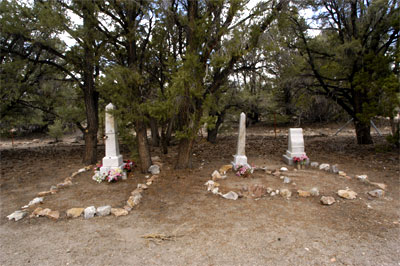 |
| The Marden graves in the
Aurora, NV, cemetery (September 2004). |
Walking around the lonesome old place made one think of all the
folks lying there, their families and their stories. Most of the burials
took place in the early years, and before 1920. Some were clearly
single men, miners from some foreign land or from the east who had been
buried by their fellow miners. Some were families in groups with one
main surname and with the added names of in-laws, the husbands of the
daughters in the family. In several cases, just a young wife who had
died too young, perhaps during childbirth, or maybe of overwork in a
harsh and lonesome environment.
One
grave marker tells a sad tale of a young family torn apart by what must
have been an epidemic of some illness that took four children all under
the age of 10 and within ten days time. This was a tall four-sided
column, engraved on all four sides with their names and dates. They
were: "Dick, age 6 died Feb.16, 1878. Frank, 8years old died
Feb.20, 1878.
Pearl
, age 2,died
Feb. 23, 1878
, and Daisy 4 years old who had died on
Feb. 26, 1878
." The engraving also states that these are the children of Horace
and Lizzie Marden. As if the loss of those four children weren't
sad enough we found another, earlier, grave there for James, Eldest son
of H. and Lizzie Marden, "age 7years 8 months, died
March 9, 1865
." Then further on another marker engraved with the name
"Hodie Marden son of Horace and Lizzie Marden, died
March 29, 1884
age 18." Lord, there were six children of this same couple,
gone, and it was almost too much to bear. Did they have other children,
or were they now left alone?
|
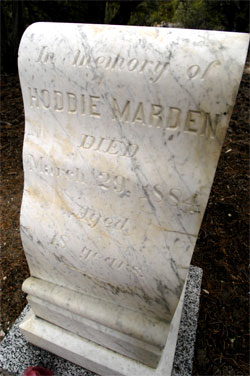
|
| Hoddie Marden's
grave in the Aurora, NV, cemetery (September 2004) |
I
just had to know more about these children and their family and
proceeded to search for the story of their lives. I was
lucky to find some data about the family and will use these
findings as well as my imagination to piece together what I believe
happened to this family.
Learning to Know The Marden Family
Horace Marden was born in
Maine
in 1832[i] and like thousands of others, Horace left for
California
during the gold rush. He crossed the Isthmus of Nicaragua and arrived in
California
before his twentieth birthday (1852). He wisely chose business
ventures other than actual mining to eke out a living. He started a
freighting business that he would eventually operate throughout the
mining country of
California
and
Nevada
for over forty years. He also built and operated stamp mills in Bodie
and Aurora. [ii]
Read
More
|
In
Search of an Elephant
by
Cecile Page Vargo
|
|
Back in the days when pathfinders were sent as forerunners to
blaze trails, and with their amigos, to fight bronco riding
Cherokees along the way, the closest thing to four-wheel drive
vehicles were covered wagons with wooden spoke wheels. These wagons
were drawn by four-legged creatures controlled by leather reigns and
whips in human hands.
Wakeman Brylarly, a foryniner struggling across the
Sierra Nevada
Mountains
, paused on
August 21, 1849
, to make the following diary entries:
“Early everything was in motion. In one mile we crossed a
little stream to the left, which runs from the
Lake
. Here we stopped, and cut sufficient grass for a feed. After
rolling one mile farther we struck the foot of the mountain. The
road was very rough and in many places steep both going up and
coming down. Every now and then there was a little table upon which
there was a little grass. We rolled thus two miles when we nooned
(or rather rested, not taking our mules out) upon one of these
tables. We stopped two hours, when we ascended a very steep and very
rocky road with many short turns around the large rocks and trees.
One mile brought us to the foot of the ‘Elephant’ itself. Here
we ‘faced the music’ and no mistake. We immediately doubled
teams, and after considerable screaming and whipping, thus arrived
safely at the top. We were but four hours ascending, and we were
much disappointed, but agreeably so, in not finding it much worse.
Certainly this must be a great improvement upon the old road, where
the wagons had to be taken across.”
Unfortunately for Brylarly he was not near is destination.
As one steep hill was descended, another one lay ahead. The
road was tougher than ever. After crossing valleys and lakes, they
came upon a divide and then to a river. Bryarly continues in his
diary:
“Everyone is liable to mistakes and everyone has a right to
call a road very bad until he sees a worse. My mistake was that I
had said I had seen ‘The Elephant’ when getting over the first
mountain. I had only seen the tail. This evening I think I saw him
in toto.”
Today in vehicles with names reminiscent of those bygone
days, we do much the same thing. The paths we travel are often
similar to those forged by hardy pioneers nearly 150 years ago.
Though road conditions are rarely as bad as they were in the olden
days, they often prove quite a challenge for our “horse powered”
four-wheel drive utility Blazers, Broncos, Pathfinders, 4Runners,
Cherokees, Amigos, etc.

The weekend comes and we load up the kids and the dogs, pack
lunches, fill the ice chest and water jug. We throw in our trusty
tow rope (just incase), and follow the existing dirt roads. In four
“high” or “low”, we travel through wet and dry river beds,
sandy gorges, and rocky, deeply rutted hills.
Sometimes we have to scout ahead on foot to see if the route
we have chosen really is passable. Often we turn around and look for
another. More often, we cover the rough spots with dirt, rocks, and
branches. We manage to drive on to the next rough spot, and begin
the rebuilding process all over again until we can finally reach our
goal, yelling and screaming and honking our horns at our
accomplishments.
 Like Wakeman Bryarly, we
find our own “elephant” and perhaps another and another. Though
not in search of rich farm lands, or lost gold mines, we find we are
able to add a little adventure to our modern day lives, and we can
re-trace the history of those who went on that original search. You
can read more about Wakeman Bryarly and other pioneers, in Francis
P. Farquhar’s “History of
the Sierra Nevada”, published by the
University
of
California Press
.
Like Wakeman Bryarly, we
find our own “elephant” and perhaps another and another. Though
not in search of rich farm lands, or lost gold mines, we find we are
able to add a little adventure to our modern day lives, and we can
re-trace the history of those who went on that original search. You
can read more about Wakeman Bryarly and other pioneers, in Francis
P. Farquhar’s “History of
the Sierra Nevada”, published by the
University
of
California Press
.
Explore Historic California wishes you and your family the
best for 2005! May you have as many adventures searching for
elephants, as we do…….. Roger, Cecile, & Marty
|
|
Our Tours with
Ecological 4-Wheeling Adventures |
|
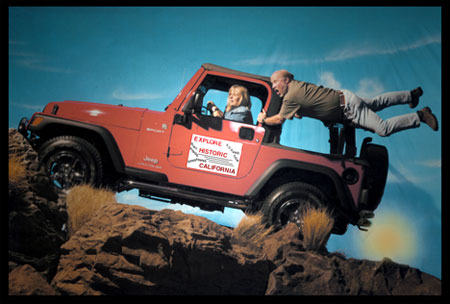
Our 2004 tour schedule is
complete and
we're doing some less
strenuous driving!
Please check back for our 2005 tour schedule.
|
|
Explore Historic California! |
|
Not too many years ago, the family station wagon was the
magic carpet to adventure. Today, that family station wagon is likely to
be a four wheel drive sport utility vehicle or pick up truck. SUV's and
other 4x4's are one of the best selling classes of vehicles. Ironically,
industry statistics show that once purchased, few owners will dare to
drive their vehicles off the paved highway. Click your mouse through our
website and enjoy our armchair adventures and the histories behind them.
If you are interested in taking one of our guided tours with your
vehicle, please visit our ECOLOGICAL 4-WHEELING ADVENTURES.
Several years ago, we bought our first SUV. We went to a one-night class
at a local community college entitled "How to 4-Wheel Drive" by Harry Lewellyn.
The following weekend we attended the hands-on day tour. We liked what we were
doing so much that we began going out nearly every weekend and learned how to
negotiate a variety of dirt roads. Our spare time was spent doing research on
the history and ecology of our favorite areas. A one-day outing turned into 16
years of leading others on mini-vacations throughout Southern California and the
Owens Valley.
Our 4WD outings involve driving on easy to moderate dirt roads and are
ideally suited to novice and intermediate level drivers. All tours are suitable
for stock vehicles in good condition, although some tours do have vehicle size
restrictions.
Our tours are
operated under permits issued by the Bureau of Land Management, U.S.
Forest Service, and other authorities.
We share our knowledge of the backcountry over the CB radio with our
guests. We frequently stop to explore mining areas, old and new, and ponder the
rocks, plants and animals we may encounter. We'll occasionally visit an old
cabin or deserted mountain lookout.
California has a fascinating history, from geologic unrest and
prehistoric petroglyph scribes to the "Radium Queen of the Mojave" and the
"Human Mole of Black Mountain." Load up your 4X, fasten your seatbelts and get
ready to explore historic California.
Roger, Cecile and Marty |
|
|

